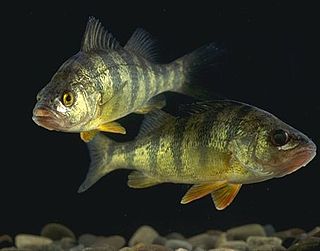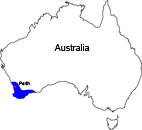
Perch is a common name for freshwater fish from the genus Perca, which belongs to the family Percidae of the large order Perciformes. The name comes from Greek: πέρκη, romanized: perke, meaning the type species of this genus, the European perch.

The yellow perch, commonly referred to as perch, striped perch, American perch or preacher is a freshwater perciform fish native to much of North America. The yellow perch was described in 1814 by Samuel Latham Mitchill from New York. It is closely related, and morphologically similar to the European perch ; and is sometimes considered a subspecies of its European counterpart.

Astacus astacus, the European crayfish, noble crayfish, or broad-fingered crayfish, is the most common species of crayfish in Europe, and a traditional food source. Like other true crayfish, A. astacus is restricted to fresh water, living only in unpolluted streams, rivers, and lakes. It is found from France throughout Central Europe, to the Balkan Peninsula, and north as far as Scandinavia and Finland, and Eastern Europe. Males may grow up to 16 cm long, and females up to 12 cm.

The Macquarie perch is an Australian native freshwater fish of the Murray-Darling river system. It is a member of the family Percichthyidae and is closely related to the golden perch.

The watercress darter is a species of freshwater ray-finned fish, a darter from the subfamily Etheostomatinae, part of the family Percidae, which also contains the perches, ruffes and pikeperches. It is endemic to the eastern United States where it is only known from the Black Warrior River drainage basin near Birmingham, Alabama.

The European perch, also known as the common perch, redfin perch, big-scaled redfin, English perch, Euro perch, Eurasian perch, Eurasian river perch, Hatch, poor man's rockfish or in Anglophone parts of Europe, simply the perch, is a predatory freshwater fish native to Europe and North Asia. It is the type species of the genus Perca.

The western pygmy perch is a species of temperate perch endemic to southwestern Australia.

Balston's pygmy perch, also known as Balston's perchlet, or king river perchlet, is a species of temperate perch endemic to Southwest Australia, where it occurs in coastal streams, ponds, lakes, and swamps. It prefers shallow, acidic waters with patches of sedge growth. This species can reach 9 cm (3.5 in) SL, though most do not exceed 6 cm (2.4 in). It can also be found in the aquarium trade.
The Yarra pygmy perch is a species of temperate perch that is endemic to southeastern Australia.
Nannoperca or pygmy perch is a genus of temperate perches endemic to freshwater systems of Australia.

Nannoperca oxleyana, commonly known as the Oxleyan pygmy perch, is a species of temperate perch endemic to Australia. It occurs in the coastal drainages of eastern Australia, being found in dune lakes, ponds, creeks, and swamps with plentiful vegetation to provide shelter. The waters in which it lives are often dark and acidic. It preys upon aquatic insects and their larvae, as well as planktonic crustaceans and even algae. This species can reach 7.5 cm (3.0 in) SL, though most do not exceed 4 cm (1.6 in). It can also be found in the aquarium trade.

Agassiz's perchlet, also known as Agassiz's glass fish and the olive perchlet, is a species of ray-finned fish in the family Ambassidae. It is semi-transparent with dark scale edges forming a pattern over most of the body. It grows to a maximum of 7.5 cm. It is a macrophyte spawner with adhesive eggs. It is endemic to Australia. It was named for the zoologist Louis Agassiz.

Galaxiella munda is a species of fish in the family Galaxiidae. It is endemic to inland waters of southwestern Australia, and known as the Western mud minnow. In 1999 the Mud Minnow was not included in the list of threatened species under the Environment Protection and Biodiversity Conservation Act, but is listed as Endangered on the IUCN Red List.
The honey blue-eye is an endangered species of fish in the subfamily Pseudomugilinae. It is endemic to southeastern Queensland, Australia, where it is found in mildly acidic, often tannin-stained, ponds and streams in wallum habitat.

Ceriagrion glabrum is a species of damselfly in the family Coenagrionidae. Its common names include common orange, common citril, common pond damsel, common waxtail, orange waxtail and gewone aljander. It is widespread in Africa, where it is found in habitats that are dominated by reeds.

Ewens Ponds is a series of three water-filled limestone sinkholes in the state of South Australia located in the gazetted locality of Eight Mile Creek, on the watercourse of Eight Mile Creek about 25 kilometres south of Mount Gambier and 8.4 kilometres east of Port MacDonnell. The ponds are popular with recreational divers due to their excellent underwater visibility. It has a small fish population including the endangered golden pygmy perch. Ewens Ponds has been part of the Ewens Ponds Conservation Park since 1976.

The common flatwing is a very common species of damselfly of the subfamily Argiolestinae in the family Megapodagrionidae. It is also known as an Australian flatwing.

The nightfish is a species of freshwater ray-finned fish, a temperate perch from the family Percichthyidae which is endemic to southwestern Australia.

The southern pygmy perch, also known as the Tasmanian pygmy perch, is a species of freshwater ray-finned fish, a temperate perch from the family Percichthyidae which is native to south-eastern Australia and Tasmania.

The little pygmy perch is a freshwater species of ray finned fish, a temperate perch from the family Percichthyidae that is endemic to south-western Western Australia. It is known from just four sites in the Denmark catchment. It is found in tannin stained, acidic and shallow streams in woodland dominated by Melaleuca rhaphiophylla.
















